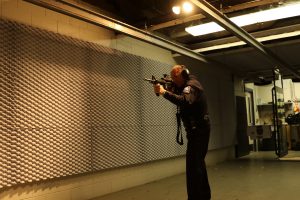
The design function for soundproofing a gun range is to mitigate noise exposure levels for both the shooter, members of the range, and the neighboring community. The definition of the noise reduction project depends on the starting point. Is this an indoor gun range or an outdoor gun range, and who are we seeking to protect from the noise.
Indoor Gun Ranges
Let’s start with the indoor gun range. These are typically long tunnels with the shooter firing down towards a target on the other end. You should first note that any attempt to soundproof the indoor gun range will not replace the need for hearing protection. You should always wear hearing protection when shooting a gun at an indoor range. The steps to soundproof the range are simply efforts to further lower exposure levels, both for decibel level readings inside the range, as well as combating noise that wants to bleed out of the space.
Acoustic Foam
Acoustic foam panels are the most popular option for curbing excessive noise levels in an indoor gun range. These panels are typically 3” thick, light gray in color, class A fire rated, and shipped to your range in 2’x4’ panel sections. Simply glue the panels to the back and side walls down the range, as well as the ceiling of the tunnel. Move the panel treatment at least 1/3 of the way down both sides of the range to ensure that you are not undertreating the space. These sound panels work to capture and convert the impact of the gun blast and lower the decibel level exposure in the room.
Sound Barriers vs Absorption
One should note, however, that acoustic foam does not “block” noise from bleeding out of the space. Sound panels simply remove the rebound of the sound wave reflections that will otherwise spike the noise level exposure within the gun range itself. But original sound can pass through the panels, through the perimeter wall and ceiling surfaces, and bleed to adjoining rooms. To combat this transfer of energy out of the room, density needs to be introduced into the equation. Think of blocking flooding water, the goal is to use sandbags, not sponges. The same holds true when combating sound bleed, you need density lined on the perimeter walls and ceilings to effectively hold the noise to within the room.
Mass Loaded Vinyl
Density can be delivered to your project site in the form of a thin mass loaded vinyl or an upgrade to a sound barrier blanket system that has the vinyl lined in the middle of the quilted blanket. In either case, the density of these treatments will combine to protect adjoining space to an indoor gun range, if properly installed. The mass loaded vinyl is a thin dense rubber that layers behind your finished surface, and can easily be appended to existing surfaces along with a channel system and a layer of plywood. The sound barrier blanket system is the upgrade, allowing you to simply flush mount the curtains to existing wall or ceiling surfaces in the gun range to combat the noise bleed out, and hold the noise to within the room.
Outdoor Gun Range
Soundproofing efforts for an exterior gun range will target these same sound barrier blankets, with a slight upgrade to make the blankets withstand the weather. These exterior grade sound barrier curtain systems can be cut up to 25’ tall. They need ground-mounted structure to suspend from, so some sort of fencing, existing wall system, or skeleton framing system needs to be constructed for these noise curtains to hang from. Note that the density of the sound blankets is what will block the noise from getting to the neighbors, so the structure that supports the blankets will need to support 1.5 pounds per square foot worth of weight.
Outdoor noise control blankets can be targeted for lining the edge of the property separating the range from the neighbor, which can prove cost-prohibitive, or the same blankets can be cut to suspend closer to the noise source, as a 3 sided phone booth, with the shooter standing inside pointing the gun towards the target. In this case, moving the soundproofing treatment closer to the source of the noise is to your benefit, as you are investing far less and trigger a much stronger decibel level drop.
Consult the Experts
So for soundproofing either an indoor or an outdoor gun range, care should be given to your starting point, the structure of the range, and the definition of who it is you are trying to protect. Working with a skilled sound consultant can save time and money when working to apply the soundproofing application for a gun range. For more help with your project, reach back to NetWell Noise Control at 1-800-638-9355 or visit us online at www.controlnoise.com